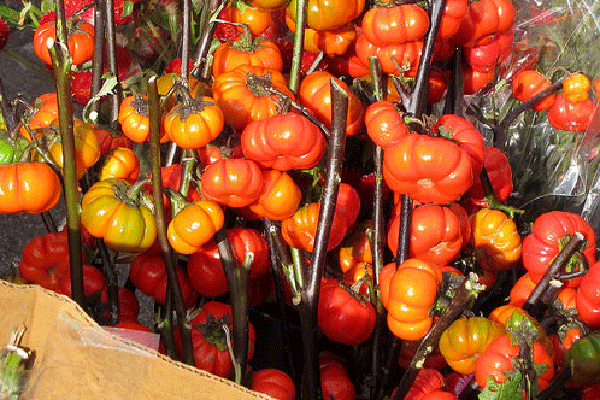Just in time for Halloween! This is no April Fool’s joke, pumpkin-on-a-stick is actually the name of a plant. Next summer, this would be a great plant to try, especially if you are trying to get your kids interested in gardening. Stems can be used like bittersweet for fall decorations.
So What Is It Really?
Also known as mock tomato, pumpkin tree or pumpkin bush, Solanum integrifolium is actually a type of eggplant grown for it’s ornamental characteristics. Botanically, it’s in the nightshade family along with tomato, potato, peppers and eggplant. Additional common names, including Hmong Eggplant, Red China Eggplant and Scarlet Chinese Eggplant, are a little more accurate and reflect the plant’s origins in Thailand. It was brought to America as an ornamental in the 1800s.
It’s easy to understand all the common-name confusion, though, since the ornamental fruits start out looking like small flat green tomatoes. They have heavily ribbed sides and eventually reach 2 to 5 inches in diameter. As they mature their coloration goes from apple green to scarlet making them look even more like little tomatoes.
If you’ve grown normal eggplant in your garden, then you know what pumpkin-on-a-stick plants look like. They reach 3-4 feet high and 2-3 feet wide, with strong upright stems and large leaves. Both the stems and leaves have thorns. On the leaves, small prickles appear on the upper side along the mid-rib. Large purple thorns are found on the stems. Clusters of small white flowers are followed by small, pale green, nubby fruits.
Growing Pumpkin-on-a-Stick
Garden requirements are the same as those for tomatoes or peppers. Full sun will create the best flower production and fruit set. Well-drained soil is essential to prevent any root diseases. Keep plants away from black walnut trees.
Since this is a tropical plant, it’s best to give your plants extra growing time by starting seeds indoors 6 weeks before our last average spring frost, which is typically about May 10th. Transplants should have at least two sets of true leaves before planting in the garden. Place your transplants outside after danger of frost has past and nighttime temperatures are consistently above 55° F. Space plants about 3 feet apart in the garden.
If you want to direct seed plants into your garden, wait until soil temperatures reach 60° F. Seed will germinate in about 14 days.
Fertilize as you would for tomatoes or peppers and keep plants well watered during dry periods. Use mulch to minimize weed growth. Although their stems are very strong and woody, staking is helpful to avoid branches breaking. All those fruits are quite heavy!
Harvesting and Using Pumpkin-on-a-Stick
Early in the season fruits can be harvested and prepared as you would any other eggplant. They are popular for stir fry dishes. Fruits are usually eaten green, but you will know they are ready to harvest when the skin becomes very shiny. Green fruits have a mild flavor, but develop a slightly bitter taste when allowed to ripen to red. Usually fruits are ready for eating in about 65-75 days from transplanting.
The first chilly fall weather encourages fruits to change in color. In about 1-2 weeks the fruits should be fully colored and ready to harvest. Fruit color fades from scarlet to orange as they dry, so now they resemble tiny pumpkins. These fruits can be harvested individually for use in display jars or entire stems can be cut with the fruits still attached.
It’s important to ensure the fruits dry properly, if they are to be used in fall decorations, to prevent rot or mold. Group stems in bunches and hang them to dry out of the sun in a well-ventilated location until the stems and leaves have dried. Any remaining leaves can be removed. Display the stems in a dry container.

